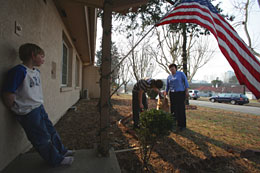
AMERICAN IDYLL: A patch of suburbia in Seoul
When 7-year-old Naomi Weiler, the daughter of German expats living in Seoul, first visited the main U.S. military base in the heart of the South Korean capital last fall, she was dazzled. "It had everything," she told classmates the next day, "and you need a special password to get in." Plenty of other Westerners relish a trip to Yongsan Garrison, for one simple reason: it's a rare opportunity to get away from the pandemonium of the big city and enjoy a slice of small-town U.S.A.
The cognitive dissonance hits you the minute you pass through the gates: Can this really be Seoul? Life within the walls is slow and surprisingly serene. Residents obey the 40 km/h speed limit, traffic is orderly and drivers actually stop at stop signs, in contrast to Seoul's chaotic driving environment. Many residents live in dun-colored, American-style three- and four-bedroom bungalows on tree-lined streets. The sidewalks are paved, toys are strewn across lawns and barbecue grills feature in the backyards. On weekends, diplomatic and military families traverse the 255-hectare installation in their SUVs and minivans, shuttling kids to soccer and football fields, the movie theater, a miniature golf course, swimming pools, bowling lanes, the shopping mall, the library and church. Golfers can hit a full bucket of balls for $5 at the driving range near the base's elementary school.
If you can get a Department of Defense cardholder to sign you in, what you'll find looks like a latter-day Norman Rockwell tableau. But this "Little America" won't be there forever. The land will be turned over to the South Koreans when U.S. forces relocate south of Seoul in 2012, and the space will be turned into a park. As with any hallucination, there'll come a time when you'll wonder if Yongsan Garrison was ever there at all.
—by Jennifer Veale